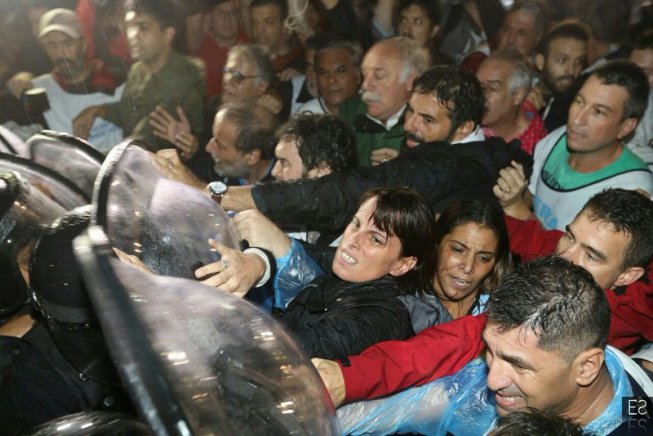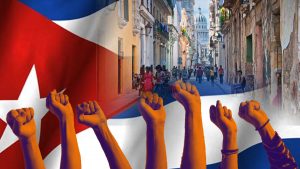This weekend, the center of the nightly scene of Roman youth moved to the University City of La Sapienza. Until a late hour, groups of students from all over Italy could be seen on the steps of the occupied departments, in lively discussions of the prospects of the student movement; others, hungry, in search of some improvised dining room where some helping of pasta is left, and the tired ones, after almost twelve hours of an assembly, preparing their sleeping bags for rest in one of the lecture halls. The 2,000 student activists who met in Rome this weekend made clear what their program was: In opposition to the plans of Minister Gelmini, they are raising the prospect of reforming the university from below, “auto-reform,” and against the policy of the government and Confindustria, the Italian bosses, they are determined to continue mobilizing and still support the December 12 general strike. The “tsunami,” as the student movement calls itself, “onda anomala” in Italian, is, in reality, to continue the metaphor of climatic and natural phenomena, only the tip of a deeper iceberg that is called class struggle.
The student “tsunami,” staggered strikes, wildcat strikes: an X ray of the social mobilization in Italy
In fact, the last 15 days were particularly turbulent. Although a large part of the Gelmini counter-reform has been definitively adopted, the high school and university students did not let down their guard, quite the contrary. Without any doubt, the biggest mobilization was the national demonstration of 200,000 people on Friday, November 14, which coincided with the general strike in university research called by the CGIL and the UIL, joined by students mobilized from all over Italy, after which met the first national student coordinating committee.
On the most directly social front, the CGIL had to reconsider their positions in the last few weeks. Meanwhile, the national leaderships of the CISL and the UIL, more disposed to dialogue, were trying to maintain a certain balance between the sense of “responsibility,” that is, negotiating with the government and the bosses over the attacks that have been swooping down on the subordinate classes, and the noticeable anger among the unions’ rank and file. The CGIL leadership and its different federations are being pressured by the existing dissatisfaction among the workers because of the economic situation and the avalanche of announcing layoffs, because of right-wing provocations by the government and, in the final instance, because of the student mobilization that is serving as a social and political sounding board symbolized by the famous “we will not pay for your crisis,” sung at all the university marches.
The CGIL leadership among government employees, had to keep the staggered strike during the first half of November, while the CISL and UIL drew back and preferred to negotiate with Berlusconi. In the commercial sector, one of the most precarious in Italy, the CGIL called the November 15 mobilization. On Tuesday, November 11, the main Italian cities had been paralyzed by a force general transportation strike, the third this year. On that same day, the workers of Alitalia, threatened with 2000 layoffs, stopped working at the Rome airport … in a “wildcat” strike, that is, without legal authorization and against even the most combative unions that until now had opposed the plan to dismantle the company agreed to by the bosses, the government and the union confederation bureaucracies.
Meanwhile, at a local level, above all in the north of the country, calls to strike against factory closings were circulating, as in Turin on November 20 and in Brescia on November 21, and the National Assembly of the FIOM metalworkers’ delegates, decided to call the December 12 strike. This date ended up becoming a general strike called by the CGIL, as Roman students in struggle had requested at the end of October, a strike that rank and file unions now joined.
Towards the December 12 general strike, to be organized from below and coordinated, the better to prepare the confrontation with the “Cavalier” and the bosses
As some militant students and workers explained in the discussions this weekend in the University City, after several weeks of mobilizations, one can begin to draw some conclusions.
All these struggles show how the union bureaucracy, especially the CGIL, that “turned to the left” in the last few weeks, is in a state of tension, between continuing to negotiate and the bosses, and, at the same time, being part of the struggles and even leading them, so as not to lose control. That explains the apparently paradoxical character of the current policy of Epifani (leader of the CGIL). Alhtough in Alitalia the CGIL signed the agreement privatizing the company, scabbing on the workers’ struggles, and although in the transportation sector the three main unions called for a strike, the better to resume negotiations with the government, Epifani found himself forced, at a global level, to change the call for a December 12 metalworkers’ strike into a call for the general strike for the first time since 2004.
Acting as a social and political sounding board, the student vanguard in struggle, in a certain sense, has made a qualitative leap in the last few weeks, as shown by the main points of the appeal by the universities in Rome, adopted on October 31, after the massive strike by teachers and students. In that appeal, reference is made to the need to coordinate all the struggles underway, and that December 12 should bethe occasion for all the union leaderships to call a strike jointly, beyond their differences. The appeal also mentions the need to set up, for the first time in years, a national student coordinating committee, that ended up by meeting on November 14 and 15 in Rome. Although student pressure managed to impose the united front between the CGIL and rank and file unions and organize a national coordinating committee that would give the mobilization a political profile of greater scope, the road we have before us continues to be very complex, to guarantee that we workers and students really do not pay for the crisis.
As shown by the ambiguous orientation of the union bureaucracy, that buries the struggles on the one hand, and calls for mobilization on the other, the question of building the strike from below among workers and students, immigrants, workers in precarious situations, and the jobless, is more urgent than ever so that the general strike will be the most incisive possible. On the other hand, the national student coordinating committee showed that students organized from below achieved more weight than if the conflicts are fragmented. A struggle to set up a national worker and student coordinating committee of the vanguards in struggle would be the best way to build a tendency capable of opposing the vacillating line of the bureaucracy in an organized fashion and at the same time the best guarantee that the current wave of mobilization goes on, by creating the most favorable possible conditions for continuing to confront a shamelessly right-wing and reactionary government and bosses that have announced a million layoffs for the coming months.
Rome, November 19
Translation by Yosef M.











